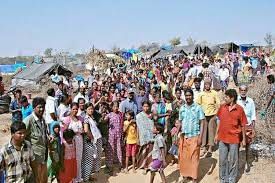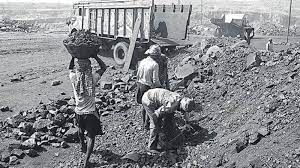UPSC Daily Current Affairs- 20th April 2023 | Current Affairs & Hindu Analysis: Daily, Weekly & Monthly PDF Download
| Table of contents |

|
| GS-I |

|
| GS-II |

|
| GS-III |

|
| What are countries around the world doing about it? |

|
GS-I
Civil Union versus Marriage
Why in News?
CJI clarified that the hearing’s scope would be limited to developing a notion of a “civil union” that finds legal recognition under the Special Marriage Act.
What is Civil Union?
- A civil union (also known as a civil partnership) is a legally recognized arrangement similar to marriage, created primarily as a means to provide recognition in law for same-sex couples.
- Civil unions would be accompanied by rights such as inheritance rights, property rights, parental rights, employment benefits to spouses, joint parenting right to abstain from testifying against one’s partner — similar to the spousal privilege given under Section 122 of the Indian Evidence Act.
Differences between the Civil Union and Marriage
- Civil partners cannot call themselves 'married' for legal purposes and Married couples cannot call themselves 'civil partners' for legal purposes.
- Civil partnerships are ended by a dissolution order. Marriage is ended by divorce, by obtaining a final order.
- Civil union is considered a step towards formal recognition of legal right to marry.
- In the wake of the legalization of same sex marriages, several civil unions were converted into marriages. For instance, In Austria, same-sex couples could form civil partnerships between the years 2010-2017. However, this changed with a court ruling that deemed civil unions discriminatory in January 2019, when such marriages were legalized.
Which other countries allow civil unions?
- In the year 2015, the Supreme Court of the United States (SCOTUS) legalized same-sex marriages across the nation with its landmark ruling in “Obergefell v. Hodges”
- From 1993, couples in Norway enjoyed the right to enter into civil unions, which gave way to a new law 15 years later, allowing such couples to marry, adopt and undergo state-sponsored artificial insemination.
- Similarly, countries like Brazil, Uruguay, Andorra, and Chile had also recognized the right of same sex couples to enter into civil unions, even before they formally recognized their legal right to marriage.
Source: The Hindu
GS-II
Animal Birth Control Rules, 2023
Why in News?
The Central Government has notified the Animal Birth Control Rules, under Prevention of Cruelty to Animal Act, 1960 and after superseding the Animal Birth Control (Dog) Rules, 2001.
Key highlights of Rules
- Animal Birth Control programme for the sterilization and immunization of stray dogs are to be carried out by the respective local bodies/municipalities/Municipal Corporations and Panchayats.
- Animal Birth Control Programme needs to be carried out by AWBI (Animal Welfare Board of India) recognized organization.
- The Municipal Corporations need to implement the ABC and Anti Rabies Program jointly.
- Also, the Cruelty involved for carrying out the ABC programme needs to be addressed.
- The Rules also provide guidelines on how to deal with the human and stray dog conflicts without relocating the dogs in an area.
Significance
- It will help in reducing the stray dog population addressing the animal welfare issues.
- It also addresses new challenges such as cat population management and resolution of conflict.
Issue of stray dogs
- India has more than 1.5 crore stray dog population.
- Over the last five years, more than 300 people — mostly children from poor and rural families — have been killed by dogs.
- Worse still, dogs are responsible for over 20,000 rabies deaths.
Other Steps taken by government
- Vaccination drives to protect stray dogs against diseases such as rabies. For example, Vaccination drive in Chennai in 2020
- Collaboration with NGOs like Blue Cross Society in Maharashtra, to conduct sterilization and vaccination drives for stray dogs.
- Awareness campaigns like “Be a Human, save a Life” by Delhi government to encourage people to adopt stray dogs and help control their population.
Source: PIB
Hakki-Pikki tribe
Why in News?
Thirty-one tribals belonging to ‘Hakki-Pikki’ are stranded in Sudan, where violent clashes between a powerful paramilitary force and the country's armed forces are going on.
About Hakki-Pikki tribe:
- They are a semi-nomadic tribal group belonging to the state of Karnataka.
- In Kannada, the word ‘Hakki’ stands for ‘bird' and ‘Pikki’ stands for the verb ‘to catch’.
- The community is known as the ‘bird catcher,’ which is their traditional occupation.
- The population is predominantly found in the Shivamogga, Davanagere and Mysuru districts of Karnataka.
- Their mother tongue was designated as 'Vaagri' by scholars.
- UNESCO has listed 'Vaagri' as one of the endangered languages.
- They have traditional medical knowledge that is in demand in several African countries.
- The community resided in the dense jungles for a long time and created its own plant and herb-based medicine systems.
Source: The Hindu
State of World Population Report 2023
Why in News?
According to the recently released United Nations Population Fund’s (UNFPA) State of World Population report India will overtake China as the world’s most populous country this year.
Key Highlights of the Report:
- India’s total fertility rate, or births per woman, was estimated at 2, lower than the world average of 2.3.
- The average life expectancy for an Indian male was projected at 71 and 74 for females.
- The report also brought up worrying statistics regarding gender rights in India.
- The adolescent birth rate per 1,000 girls aged 15–19 was 11, while 23 per cent of girls were married off before the age of 18.
Key facts about the United Nations Population Fund’s (UNFPA)
- It is an international development agency created in 1968 to support the execution of projects and programmes in the area of population and sexual and reproductive health.
- Its mission is to deliver a world where every pregnancy is wanted, every childbirth is safe and every young person's potential is fulfilled.
- In 1987, it was officially renamed as the United Nations Population Fund but the original abbreviation UNFPA (United Nations Fund for Population Activities) was retained.
- Headquarters: New York
- It is not directly responsible for the collection of primary statistics; it plays an important role in the technical and financial support of statistical activities in countries, such as population censuses and thematic surveys etc.
Source: Down to Earth
GS-III
Blastomycosis
Why in News?
At least one person died and around a 100 were confirmed or suspected to be infected of blastomycosis in the US.
Blastomycosis
- About:
- It is an infection caused by a fungus called Blastomyces. The fungus lives in the environment, particularly in moist soil and in decomposing matter such as wood and leaves.
- Transmission:
- People can get blastomycosis after breathing in the microscopic fungal spores from the air.
- Blastomycosis doesn’t spread between people or between people and animals through the air. In extremely rare cases, blastomycosis has been spread between infected people or animals through needlestick injuries, bites, or sexual contact.
- Symptoms:
- Fever, Cough, Night sweats, Muscle aches or joint pain.
- Prevention:
- No vaccine to prevent blastomycosis.
- Itraconazole is a type of antifungal medication that is typically used to treat mild to moderate blastomycosis.
Source: PIB
Critical Minerals and India
Why in News?
A recent working paper from Centre for Social and Economic Progress (CSEP) extends the earlier minerals assessment for 23 minerals by assessing the criticality levels of 43 select minerals for India.
- This is based on their economic importance (demand-side factors) and supply risks (supply-side factors) which are determined through the evaluation of specific indicators.
- Critical minerals are elements that are crucial to modern-day technologies and are at risk of supply chain disruptions.
- These minerals are used in making mobile phones, computers, batteries, electric vehicles, and green technologies like solar panels and wind turbines.
- Minerals such as antimony, cobalt, gallium, graphite, lithium, nickel, niobium, and strontium are among the 22 assessed to be critical for India.
- Many of these are required to meet the manufacturing needs of green technologies, high-tech equipment, aviation, and national defence.
- Clean energy transition: Critical minerals are essential to the ecosystem that fuels the world’s transition towards clean energy and digital economy.
- Strategic nature: Any supply shock can severely imperil the economy and strategic autonomy of a country that is over-dependent on others to procure critical minerals.
- Rare availability: Supply risks exist due to rare availability, growing demand, and complex processing value chain.
- Dominant role: China is the world’s largest producer of 16 critical minerals, including cobalt and rare earth elements.
- Monopoly in processing: The country has a strong presence across the board in processing operations, with a share of refining around 35% for nickel, 50-70% for lithium and cobalt, and nearly 90% for rare earth elements.
- Control over offshore mines: China also controls cobalt mines in the Democratic Republic of Congo, from where 70% of this mineral is sourced.
- Supply chain dominance: The country’s dominance in critical minerals production and processing raises concerns of a supply disruption in case of a geopolitical conflict.
- Limited availability of critical minerals: The rare availability of critical minerals poses a challenge in meeting the growing demand for these minerals.
- Geopolitical risks: Complex supply chains can be disrupted by hostile regimes or politically unstable regions, leading to supply chain disruptions.
- Dominance of certain countries: A few countries, such as China, are the dominant producers of critical minerals, leading to concerns over supply disruptions in case of a geopolitical conflict.
- Increasing demand for critical minerals: With the shift towards renewable energy technologies and electric vehicles, the demand for critical minerals such as copper, lithium, and rare earth elements is increasing rapidly.
- Reliance on foreign partners: Countries with limited reserves and higher requirements for critical minerals may have to rely on foreign partners to meet their domestic needs, leading to supply chain vulnerabilities.
- Environmental and social concerns: The extraction and processing of critical minerals can have negative environmental and social impacts, leading to challenges in meeting sustainability goals.
What are countries around the world doing about it?
Several countries are taking measures to ensure a consistent supply of critical minerals to their domestic markets.- India: It has set up Khanij Bidesh India Ltd. (KABIL), a joint venture of three public sector companies, to ensure a consistent supply of critical and strategic minerals to the Indian domestic market.
- US: It has ordered a review of vulnerabilities in its critical minerals supply chains and shifted its focus on expanding domestic mining, production, processing, and recycling of critical minerals and materials.
- Australia: Its Critical Minerals Facilitation Office (CMFO) and KABIL had recently signed an MoU aimed at ensuring reliable supply of critical minerals to India.
- UK: It has unveiled its new Critical Minerals Intelligence Centre to study the future demand for and supply of these minerals, and its critical mineral strategy will be unveiled later this year.
- Developing domestic sources of critical minerals: This can be achieved by promoting exploration and mining activities, both by public and private sector entities.
- Encouraging responsible mining practices: The Indian government should encourage responsible mining practices that minimize negative environmental and social impacts of mining activities.
- Developing recycling capabilities: This can be achieved by promoting research and development in recycling technologies and incentivizing the adoption of recycling practices.
- Promoting transparency in the supply chain: India should promote transparency in the critical minerals supply chain by ensuring the traceability of minerals from the point of extraction to the point of end-use.
- Investing in research and development: India should invest in research and development to develop new technologies and processes for efficient extraction, processing, and recycling of critical minerals.
- Developing a national critical minerals strategy: India should develop a national critical minerals strategy that identifies priority minerals, promotes domestic exploration and mining, and promotes sustainable and responsible mining practices.
- India has a significant mineral geological potential, many minerals are not readily available domestically.
- Hence, India needs to develop a national strategy to ensure resilient critical minerals supply chains, which focuses on minerals found to be critical in this study.
Source: Indian Express
What is YZ Ceti b?
Why in News?
Recently, astronomers have detected a repeating radio signal from the YZ Ceti b exoplanet that suggests the presence of a magnetic field around it.
About YZ Ceti b:
- It is a rocky earth-sized exoplanet rotating around a small red dwarf star.
- It is barely 12 light-years from Earth.
- The astronomers determined that the planet takes just a couple of Earth days to circle its star.
Why does the magnetic field matter?
- The survival of a planet’s atmosphere may well depend on its strong magnetic field.
- The magnetic field protects the planet’s atmosphere from being eroded by the charged particles blowing in from its star.
Key Facts about the Exoplanets
- These are also called extrasolar planets.
- These are a planetary body which is outside the solar systemand that usually orbit a star other than the Sun.
- Exoplanets come in a wide variety of sizes, from gas giants larger than Jupiter to small, rocky planets about as big around as Earth or Mars.
- These are made up of elements similar to those of the planets in our solar system, but their mixes of those elements may differ.
- Most exoplanets are found through indirect methods: measuring the dimming of a star that happens to have a planet pass in front of it, called the transit method
Source: The Hindu
|
44 videos|5271 docs|1113 tests
|
FAQs on UPSC Daily Current Affairs- 20th April 2023 - Current Affairs & Hindu Analysis: Daily, Weekly & Monthly
| 1. What is the significance of GS-I, GS-II, and GS-III in UPSC exams? |  |
| 2. What is the syllabus for GS-I in UPSC exams? |  |
| 3. What are the subjects covered in GS-II in UPSC exams? |  |
| 4. What are the topics included in GS-III in UPSC exams? |  |
| 5. How should one prepare for GS-I, GS-II, and GS-III in UPSC exams? |  |






















